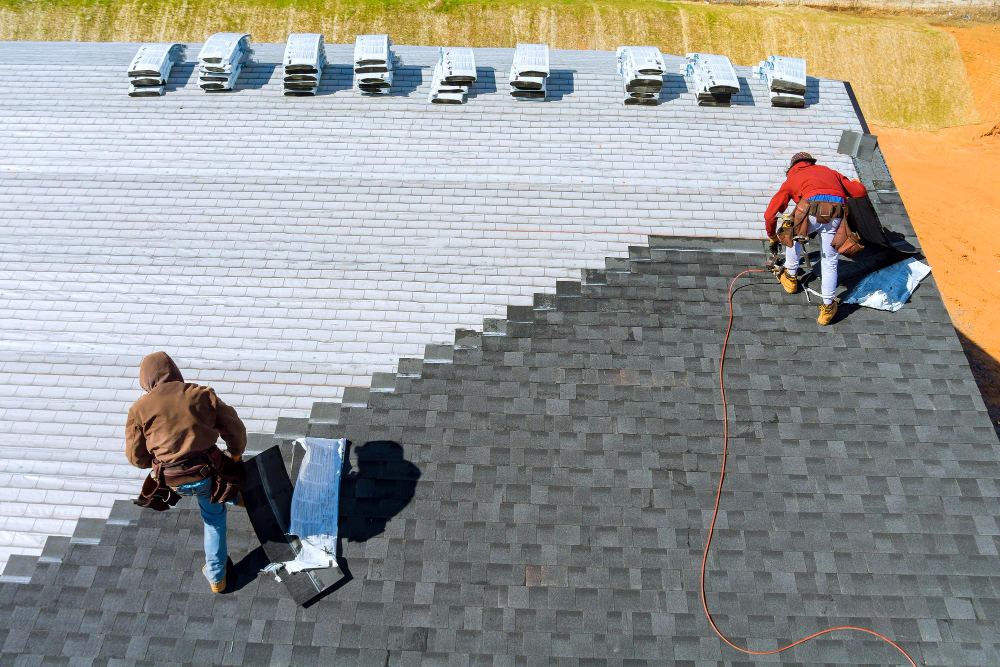When you observe your roof, you only see shingles. What you don’t know about is that there’s a whole system of layers underneath. Each layer is doing its job to keep your home safe, dry, and comfortable. From the base deck to the outer shingles, every layer has a purpose.
In this blog, we’ll break down the main layers that make up a roof, explain how they work together, and answer a common question homeowners have: how many layers of shingles can a roof actually have?
How Many Layers Does a Standard Roof Have?
Several layers of your roof are working together to keep your home safe and dry. The followings are basic roof layers explained:
1. Framing & Decking — the foundation
This is the “skeleton” of your roof. The framing gives the roof its shape, while the decking is laid on top to create a solid base for other layers. Without this, the rest of the roof can’t be installed.
2. Underlayment & Water Barrier — first line of defense
It works as the raincoat of your roof. It gives protection as it is present between the decking and shingles. It helps to stop water from seeping through if the shingles get damaged. It also protects in case of heavy rainfall.
3. Flashing — keeps water away from weak spots
It is made from thin sheets of metal and is present around vents and chimneys. Flashing is placed around the areas where there is a possibility that water can get inside. It directs water away from those vulnerable spots to protect them from leaking.
4. Shingles or Roofing Material — the outer shell
You can see this part of the roof. Shingles protect your home from the natural elements like rain or sunlight. They also give your home a finished look.
5. Ventilation, Fascia and Soffit — airflow & edge protection
Good airflow prevents heat and moisture build-up. Ventilation systems help with that. The fascia is the board that runs along the roof edge, supporting the gutter, while the soffit is tucked under the eaves to keep pests out and air moving.
6. Optional Extras — for added protection
Your roof might also include extras based on your home location. Your home might have ice shields that help to prevent ice dams or starter shingles that give the first row an extra strength. These additions may help to make your roof more durable.
How Many Shingle Layers Can a Roof Have?
Shingles are the flat pieces that cover the outside of a roof. Most building codes suggest a shingle can have a maximum of two layers. Some people add a second layer to save money and avoid tearing off the old roof.
If you add another layer, it isn’t the best idea, as it can lead to the following issues:
- Too heavy – Extra weight can strain the roof.
- Hidden problems – You’ll not be able to see the damaged wood present underneath
- Shorter life – You’ll not be able to detect the issues leading to the reduced lifespan of your roof.
That’s why it is advised to remove the old one before installing the new shingle roof layers. It gives your roof a stronger foundation.
Why Every Layer Matters
Every roof layer section has an important role. If one is missing or done wrong, problems can follow. Here’s why each layer counts:
Leaks
The Missing layers let water slip in and damage your home.
Mold growth
Without proper layers, there are chances of mold formation.
Poor insulation
Weak or missing layers can cause heat to be trapped inside during hot weather and let heat escape in winter.
Structural damage
Moisture can rot the wood and cause the roof frame to become weak.
Higher energy costs
The heating and cooling systems work overtime due to the poor insulation.
Myths About Roof Layers
The following are some common misunderstandings with the correction under each misconception about roof systems, whether pitched or flat roof layers:
More layers mean better insulation
No, adding extra material doesn’t make your roof warmer. You need to do the proper insulation for this purpose.
Underlayment is optional
This is a myth; if you skip the underlayment, your home will be exposed to leaks and moisture damage.
Keep stacking shingles
It isn’t true, as most codes only allow two layers, and adding more creates a serious problem.
Conclusion
The roof system is built of several layers, and every part plays an important role. Your home stays protected if all of these layers are installed properly. The proper maintenance is equally important, as it helps to protect your home from damage.
Trust the team at Rockford Coastal Homes. We are experienced in building sturdy and up-to-standard roofs for homes and commercial buildings.


